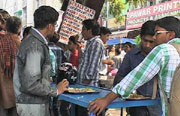VOA标准英语2011--Changing Indian Lifestyles Fuel 'Twin Epidemics' of Health Problems(在线收听)
Changing Indian Lifestyles Fuel 'Twin Epidemics' of Health Problems
New research shows India is experiencing a sharp rise in two major medical conditions typically associated with wealthier nations. Changing lifestyles and economic prosperity are seen as fueling the trend.
The study, "Screening India's Twin Epidemic," surveyed a nationwide sample of nearly 16,000 participants, nearly half of whom had hypertension, or high blood pressure. More than a third had diabetes, and about a fifth had both conditions.
Doctors say South Asians are genetically more prone to diabetes, and cases of the disease have been rising in India for the past 10 years. The country has more than 50 million diabetics.
The executive chairman at the Fortis Center for Diabetes and Metabolic Diseases in New Delhi, Dr. Anoop Misra, described diabetes as a lifestyle disease, fueled by urbanization and industrialization.
“So the indiscretion in the food intake has increased markedly over a period of time. At the same time, the physical inactivity has increased, more mechanization," said Misra. "And also, stress has increased. Smoking remains a significant problem, as well as alcohol intake has increased over a period of time.”
Changing dining habits
 |
| New research shows India is experiencing a sharp rise in hypertension and diabetes that is being fueled by urbanization, industrialization and prosperity, November 2011. |
Misra said the age-old tradition in India of frugal eating at home is increasingly being replaced with dining out. Those benefiting from India's economic rise have more money to spend on fast food from chain restaurants and street vendors.
The changing urban economy also has displaced gender roles. Many people say female family members used to be responsible for preparing the simple staple foods India has long relied on.
“But nowadays, since everybody is professional, even our wives are working, so it will be much more problematic for us to do that,” said librarian Kapil Sachdeva.
Empty calories, sedentary lifestyle
Consuming empty calories is getting cheaper in urban areas. Cheap snacks like sugared cola and potato chips, however, also are increasingly available in rural areas, where Indians may not have the access to physicians who can diagnose and treat diabetes.
“And in another 10 years, we will have same status in rural areas, as far as diabetes is concerned, as we see now in urban area,” said Misra.
As living standards rise and the nature of work becomes more sedentary, the cost of burning calories rises in comparison to India's mainly agricultural past. Longer commuting distances and easier access to transportation mean more sitting around.
“In my dad's time, he used to go to office by his bicycle first, so lot of hard work and physical movement was there," said Sandeep Sharma, a business manager. "But now we drive our car to office and we drive back by our car only. So [too much of] less physical activities are there.”
India's government has launched a pilot program to spread awareness about diabetes, to bring the disease under control, especially in the countryside. The task is urgent. Doctors warn cases of diabetes could skyrocket by 150 percent, in the next 20 years.